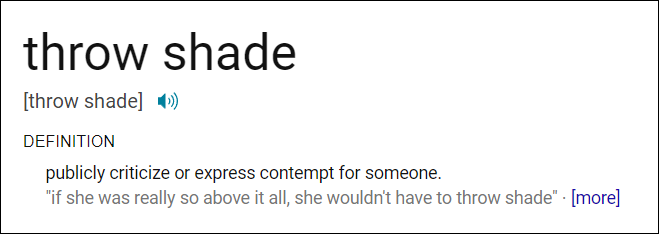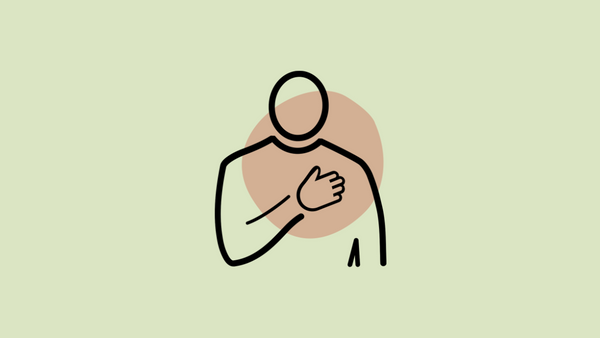Throwing shade a couple of decades ago may have been a sweet gesture of shielding someone (or oneself) from the sun and heat. Today, and by that, we mean in the late 1900s, to ‘throw shade’ came to have a whole new definition. This, however, does not disregard the fact that ‘throwing shade’ was actually an age-old slang.
If you’re familiar with English literature, and more so with Jane Austen, you may agree if we were to say she probably coined the slang usage of ‘throwing shade’. It may be close to two centuries, it may be over just about two decades old, but ‘throwing shade’ has been the internet’s favorite way of retaliation or recognizing it.
What Does it Mean When Someone ‘Throws Shade’?

That someone can be you too.
‘Throwing shade’ may be a popular phrase on the internet, but that doesn’t restrict its use-case to real life! To ‘throw shade’ means to belittle, dismiss, show disgust, disapproval, disbelief, insult, degrade, or negatively condemn verbally or non-verbally (with bodily gestures). So, when you come across this phrase, it can mean any of the mentioned things, both online and offline.
Before dissecting the slang to understand it, it’s important to note that ‘throwing shade’ is a subjective act of expressing a negative response with words or actions. This response either has solid moral grounds or is simply an outrage stemming from personal dislikes. There’s no set reason for throwing shade if not for momentary or lasting subjective negativity.
However, when someone does throw shade, it could mean a couple of things, like:
- Feelings of repulsion
- Outrage
- Instant need to self-defend with mockery or insults
- Degradation
- Sarcasm with underlying truth to it
- Jealousy/envy
- A dying need to look/seem superior (could hint at an inferiority complex)
- Begging to differ
- Lashing out
- Not agreeing to disagree
The Nature of ‘Throwing Shade’
When we say ‘throw shade,’ a lot is going on there. Firstly, why shade? What’s the significance of this word in this slang? And secondly, why’s it “thrown”?
‘Shade’, in its literal sense, is cooling and comforting. It shelters from heat, light, and harshness in any shape or form. But the internet version of the same word has an entirely different meaning. Here, ‘shade’ is synonymous with ‘disrespect’. It encompasses the whole slang of ‘throwing shade’; open disrespect that brackets all the emotions, responses, and feelings the slang signifies.
Disrespect, as we know it, is heavy. It hardly evokes a positive connotation, even when it’s supposedly well-deserved. To disrespect something is to devalue it ultimately. Now, something this heavy is never ‘given’, ‘shared’, ‘passed onto’, or ‘handed over’; it is thrown. The ‘throw’ here has two impacts — one, the burden it carries, and two, the emotion/feeling it’s conveying.
“Throwing” shade emphasizes the negative emotion or feeling that it’s communicating. The slang itself punches enough to do justice to the actual act of throwing shade. When someone is irritated by something, they get filterless. They wish to convey their repulse as much as possible and to the correct extent — and ‘throwing’ response is the perfect way to capture this complex negative feedback.
The POV behind and in front of throwing shade
Quite often, ‘throw/throwing/threw shade’ is used in the second/third person while narrating an uncomfortable, questionable, possibly humorous, and badass event. It can be used in the first person too, but more often than not, it’s in the passive voice.
We usually hear how someone threw shade rather than how someone is going to do the same. Throwing shade is mostly applied in the context of an observation than a dedicated first-person statement of the same.
Like,’She was constantly throwing shade at him for his attitude’ is generally the context for the slang as opposed to ‘Watch me throw some shade for his attitude’ or ‘I threw shade at him the whole time for his attitude.
Nevertheless, the slang stands equally relevant and impactful irrespective of the point of view; the narrative has the same emotion.
Verbal or non-verbal cues?
‘Shade’ can be thrown verbally and non-verbally. It’s an effective response that works the same almost every time regardless of reception. It doesn’t entirely matter if the recipient received the shade or acknowledged it. The slang stands implied as long as it’s off someone’s chest and the same is narrated if someone witnessed it. Often the ‘shade thrower’ is oblivious to the fact they’re throwing shade. Hence, the slang is generally used when someone observes it.
The verbal way of throwing shade is quite literal and straightforward. A person uses words to articulate the emotion they’re feeling. This can be in-person, online, or over the phone. When shade or disrespect involves verbal language, it is considered verbally throwing shade. Like, ‘I see everything but choose to ignore the frames with you in them’, or ‘Geez, the kind of shade you keep throwing is unbelievable, dude’. This type of shade can be referred to in the first person or narrated as such.
Non-verbal methods of throwing shade include using bodily gestures, emojis, facial expressions, physical reactions like sighs, eye-rolls, physical movement as cues to convey disrespect. There must be constant, real-time presence at the event if you were to speak of non-verbal shade.
Unlike verbal shade, non-verbal shade is slightly more challenging to understand, observe, or translate — but it can only be verbally narrated. The first-person involvement, of course, doesn’t involve words. For example, ‘___ forgot to turn off her camera and she was throwing shade at ____ the whole time’ or ‘____ threw shade like nobody’s business, it as wonderful.
How to Recognize ‘Shade’ and Use ‘Throw Shade’ Slang?
‘Shade’ is both a verbal slur and a non-verbal sign intended to show contempt. You can use ‘throw shade’ in two different contexts carrying the same meaning. However, before using the slang, it is important to first recognize ‘shade’.
Recognizing verbal ‘shade’
It’s relatively and evidently easier to recognize verbal shade than non-verbal shade. But, that doesn’t make it simple. Sometimes, even words can deviate from the list of signs that make something a ‘shade’ — especially when there’s sarcasm or indirect mockery involved. In such situations, trust to tonality. You may not be able to register ‘shade’ via words, but you can always notice it via the convincing tone it carries.
Another aspect that you can factor in while identifying ‘shade’ in-person and via verbal communication is, ironically, non-verbal cues. Many times, many people talk with their bodies just as much as with words. So, if you’re ever confused, you can tell a ‘shade’ by a person’s body language even in verbal scenarios.
Using ‘Throw Shade’ while narrating throwing verbal shade
Once you’ve recognized verbal shade; online or offline, you can use ‘throw shade’ to describe the event. For example, ‘He’s just throwing shade like he’s invisible. So uncomfortable’, ‘She was all smiles and sweet-talking but I swear I could tell that she was hard-core throwing shade at me for saying that’, ‘He asked how much I paid for my house and smirked after saying “Pretty sure I make more than that”. WHAT A JERK’.
You can also use ‘throw shade’ verbally even before the event of throwing shade. That is while referring to the action of disrespecting and not narrating it. Here, ‘throw shade’ is used in the first or second person. Like, ‘Look. I don’t care what happened between the two of you but it is NEVER right to throw shade at each other in the meeting room!’ or ‘I probably should’ve clapped back just when he threw shade at me. But, not my bad, I could’ve never seen it coming’.
Recognizing non-verbal ‘shade’
Non-verbal shade may sound like it’s difficult to highlight, but, if you’re a good observer, then, this is a piece of cake. When a person throws shade non-verbally, there’s a shift in their behavior. They may seem more closed, serious, and negative. If you’re new to recognizing non-verbal shade, it can be a suffocating experience.
Some of the more common non-verbal ways of throwing shade are head shakes, raising an eyebrow(s), the “eye talk” (a dead look at someone/something, visually sizing someone/something, looking literally ‘down’ or from the corner of the eye at something or someone), moving away from the source, etc.
Non-verbal cues of throwing shade also get culture-specific. Disrespect may have some universal gestures, but it also has some gestures that are particular to a country/culture/community. So, if someone’s using such specific gestures to show disrespect, then, that too, counts as throwing shade.
Using ‘Throw Shade’ while narrating throwing non-verbal shade
As mentioned before, you can use ‘throw shade’ to only narrate a scene of throwing non-verbal shade. So, if you find/found anyone bodily expressing distaste for someone or something, use ‘throw shade’ while referring to it. For instance,
- He always rolls his eyes at me when I try talking to him about it.
The dude never gets tired of throwing shade, huh.
Yep. Never. - For some reason she looked like she was going to throw up when I came home with a haircut.
Oh, my. So much shade. - Look. I’m pretty sure you’re shaking your head rn. STOP throwing shade at me when I can’t see it!! (over text).
Analysis
‘Throwing shade’ may be a new slang, but the practice is inherent in human psychology. It’s not necessarily a bad thing, but, it’s neither good. Sometimes, ‘shade’, in this context can be a really good backlash for a shady conversation, but if there’s no source for a comeback, then, that’s just an arrogant display of one’s dislikes; a baseless reason for unnecessary (and possibly) hurtful ‘shade’.
‘Throwing shade’ goes against the good old amiable policy of ‘saying nothing when you have nothing nice to say’. Here, the person takes the opportunity (actually, seizes the moment) to say something nasty with a subjective cause — which is a pretty questionable act. But, it does stir drama, and who doesn’t like a good dose of drama! This is possibly why ‘shade’ makes news mostly in the celebrity sphere. In fact, ‘shade’ is more talked about when one celeb overtly or covertly disses another.
The act of throwing shade, by nature, is purposeless. The whole objective of throwing shade is selfish as it is done to make oneself feel better in a plausibly vulnerable situation. When someone’s image, judgment, values, opinions, etc., are criticized or not accepted as expected, there lies a reason to clap back with shade. It’s a silly reaction that would probably perpetuate a cold war if the other person is reactive as well.
Negativity is all fun and games until it is done in good humor. To put it subtler, disrespect is fine as long as there’s either an underlying understanding between the involved or an eventual apology by the shade thrower. It’s simply naive and uncalled for otherwise.
Conclusion
‘Throw shade’ has been the slang way of referring to disrespect for a very long time now. The slang is popular in both informal and formal contexts; after all, disrespect has no designated situation. It can happen anywhere, anytime. It’s cool to throw shade, but at its core, it’s really unnecessary. Nevertheless, disrespect is a prevalent practice, and ‘throwing shade’ is a euphemism for it.










Member discussion